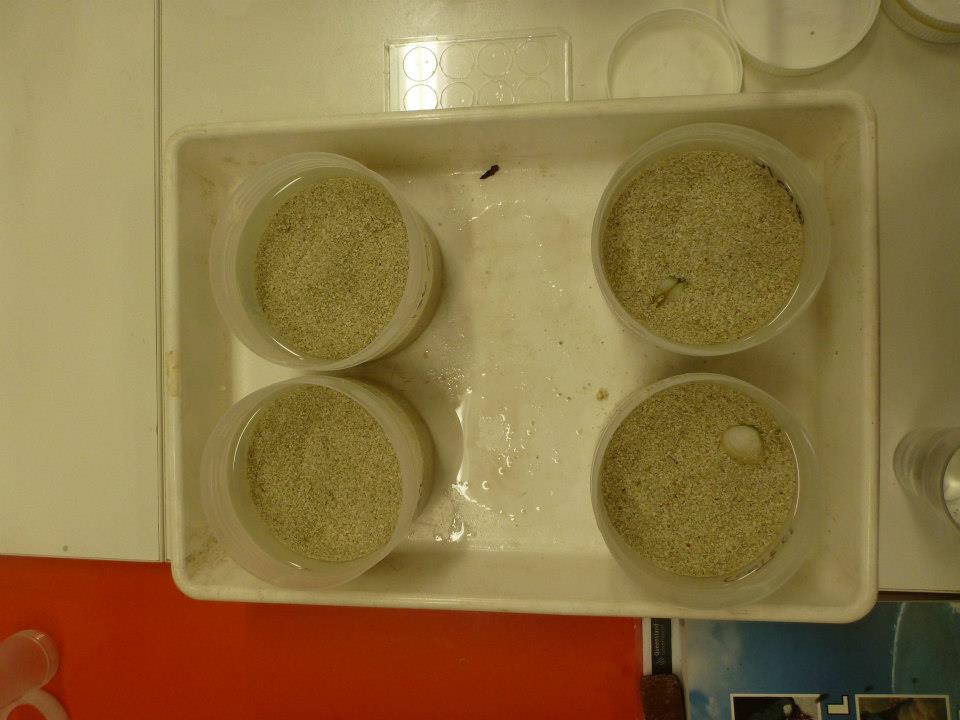Introduction
This study was undertaken to investigate the effects of elevated concentrations of copper on M. rufescens burrowing behaviour. This study was conducted in light of recent concerns about sediment plumes associated with the dredging of Gladstone Harbour. Understanding how elevated heavy metal concentrations affect the behaviour of these invertebrates may be useful for management of future complications assosiated with the re-suspension of sediments containing heavy metals. With enough research it is entirely possible that these bivalves could be used as an indicator species to assess the effects of pollution on ecosystems.
Methods
A number of specimens of M. Rufescens were collected fromthe sandy intertidal habitat. The organisms were sorted into four groups with six (6) organisms in each group. Each group was made up of similar sized individuals to ensure no bias due to size differences was included in the study.
Four containers were prepared for the experiment. Sand that had been passed through a 2mm sieve to remove large particles was placed in each container to a depth of 7cm. 500mL of seawater was added to each container. Concentrations of 50, 100 and 150 micrograms were chosen for copper concentrations, as these were the similar to what Bonnard et al. (2009) used in their study. These concentrated copper solutions were obtained by making a 10mg/L solution using Copper Sulfate and diluting it further until the desired concentrations were acquired for the values necessary.These solutions were then pipetted into the water of the test containers. The organisms were then added to each container. The bivalves were then left to acclimatise for 23 hours before investigations into the effects of the copper on their burrowing behaviour were undertaken.

Figure 1: The experimental set-up with four different levels of copper concentration.
For each test, the six organisms in each of the four containers were dug up out of the sediment that they were in and placed on the top of the sediment. Every two minutes, the number of unburrowed organisms was recorded until all organisms had burrowed or 30 minutes had elapsed. This was repeated three times, with the time the bivalves had been exposed to the copper solution recorded before each test.
Results
In all three tests, the organisms that had been exposed to copper tended to burrow into the sediment before the control organisms did. There didn’t appear to be any correlation between increasing copper concentration in the water and time taken to burrow.

Figure 2: The percentage of unburrowed organisms in each treatment after 23 hours exposure to copper solutions. In the first test all of the organisms apart from the control were completely burrowed after 16 minutes while 50% of the control organisms were still unburrowed after 30 minutes had elapsed.

Figure 3: The percentage of unburrowed organisms in each treatment after 24 hours exposure to copper solutions. All of the test organisms in the water treated with copper burrowed after 22 minutes while the control still had 50% of the organisms unburrowed after 30 minutes.

Figure 4: The percentage of unburrowed organisms in each treatment after 25 hours exposure to copper solutions. In the first test all of the organisms apart from the control were completely burrowed after 26 minutes while 50% of the control organisms were still unburrowed after 30 minutes had elapsed.
Discussion
It appears that M. Rufescensare very sensitive to changes in trace elements of heavy metals. The bivalves all burrowed into the sediment much more quickly when they were exposed to any level of copper. Previous studies found that bio-accumulation of copper in the tissues of bivalves had an impact on the enzymes of the organism that were responsible for muscle contractions related to burrowing. Due to time constraints, the organisms in this test could not be exposed to the copper contaminated water for long enough for this to occur. It could be theorised from these results that the chemosensory systems of M. rufescens are very senstive to changes in trace elements of heavy metals in their environment and have well developed systems to monitor these changes. |